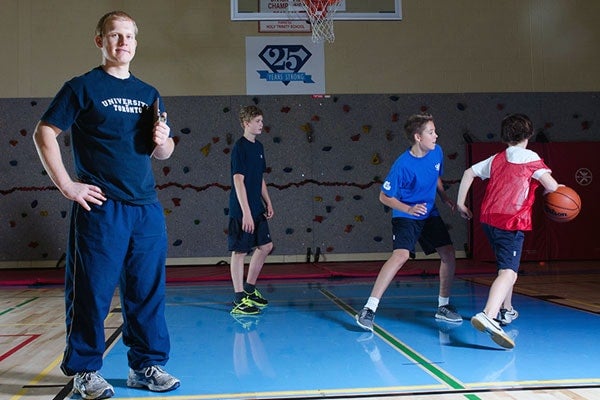
Kids' health: exercise and participation
Published: December 11, 2013
Physicians, exercise physiologists and healthcare organizations emphasize the importance of regular physical activity for lifelong good health. But data show that youth today are less active than in the past, says Patrick Jachyra.
Some might blame the prevalence of video games and other online amusements, but the University of Toronto's Jachyra, a master’s candidate at the Faculty of Kinesiology & Physical Education, is determined to dig deeper. In doing so, he has turned to Sterling Hall, a private Toronto boys’ school that has a research partnership with U of T through its Sterling Institute.
“This is a qualitative case study to understand the dominant practices,” said Jachyra, who is supervised by Professor Michael Atkinson. “I want to know if early experiences in life translate into a desire to participate – or not – in exercise later on.”
Jachyra said the statistics indicate that boys today are more inactive than girls, especially as adolescence approaches. Thus, Sterling Hall physical education classes provide an ideal venue to study young boys and their involvement with physical activity. The day school has an ethos of participation, said Jachyra, and there is a strong focus on sports, physical activity, fitness testing and cardio endurance.
He has spent two three-month periods working with the physical education classes there, building trust and assisting, observing and talking with the students. This winter, he plans to spend another three months making additional observations.
“I spend time with both the high-ability and low-ability kids,” Jachyra said. “I want to understand their experiences to build a more inclusive approach to physical education.
“I’m trying to develop a teaching practice and philosophy that will increase the physical activity levels in general for both groups. If we can understand what drives them to participate, we can change things so they enjoy the experience.”
He notes that a hierarchy is quickly apparent in the classes, reflecting those who are skilled at sports and those who are not. Jachyra observes that the athletically-talented students love competition; some of the less gifted athletes do, also, but they have fewer opportunities to win.
"One of the most interesting findings is that kids who don’t participate much in class told me that they want to keep active,” he said. “They are generally involved in alternate sports that haven’t migrated into the physical education paradigm: taekwondo, kung fu or Parkour, for example.
“Can we potentially use other activities to achieve the same (health and activity) outcomes, instead of focusing only on sport? There are other physical activity cultures we can be making use of and we’re not. It might help the kids who don’t fit in with the dominant group. We can find ways to make exercise rewarding for kids of all abilities.”
Jachyra hopes to bring his work to the attention of both the academic community and the teaching community. His goal is to see these ideas applied in the field.
“I want to try to influence the teaching community and benefit the teaching practice,” he said. “By providing alternative ideas from evidence-based research findings, I can influence policies and procedures.”
Elaine Smith is a writer with the Faculty of Kinesiology and Physical Education at the University of Toronto.



